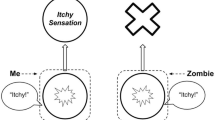Abstract
Proponents of the hard problem of consciousness argue that the zombie and inverted spectrum thought experiments demonstrate that consciousness cannot be physical. They present scenarios designed to demonstrate that it is conceivable that a physical replica of someone can have radically different or no conscious experiences, that such an experience-less replica is possible and therefore that materialism is false. I will argue that once one understands the limitations that the physics of this world puts on cognitive systems, zombies and the inverted spectrum are not conceivable.
Similar content being viewed by others
Notes
I have glossed over the difference between 1- and 2- conceivability that is required by Chalmers’ two-dimensional semantics. Given that 2-dimensional semantics complicates the second premise and I am denying the first it is unnecessary to explicitly represent the complicating details. This should not involve any begging of the question as Chalmers regularly presents the argument in this way (Chalmers 2010).
Precisely what it is about consciousness that is problematic, and even if there is something problematic, is up for debate (see the papers in Shear 1997). It is therefore difficult to choose a term to gesture at the phenomenon. I have chosen to use the term “phenomenal experiences” to remain neutral on issues such as whether “consciousness” is better used to refer to awareness than what it is likeness (Rosenthal 1991; Kriegel 2005), whether there is a distinction between phenomenal and access consciousness (Block 1995) and to accommodate sceptics about the existence of phenomenal properties (Dennett 1993).
Chalmers suggests that we can see the in-principle gap once we understand that physical explanations are in terms of structure and function and consciousness is the phenomenon which cannot be given a structural and functional explanation. But all Chalmers seems to have to support this claim is an intuition (Carruthers and Schier 2014).
Note the Twin Earth thought experiment was developed to support content externalism not dualism.
When the cooling is coming from uniformly around the body of water it will freeze from the outside in, as anyone who has taken a partially frozen bottle of water from the freezer can attest.
Unless otherwise mentioned all references to Dennett are from Consciousness Explained.
Note this does not require connectionism. Classical computers are capable of being parallel in the required sense that multiple computational are occurring simultaneously (Fodor and Pylyshyn 1988).
An anonymous reviewer asked for my thoughts on Russellian monism pointing out that such a view also denies the ideal conceivability of zombies and inverts. Part of Russell’s motivation for adopting neutral monism was a desire to keep the simplicity of monism without having to bridge the gap between the mental and the physical (Chalmers 2010, 133; Studenberg 2016). It seems to me that to the extent that this current paper bridges the gap between the mental and the physical is the extent to which we have removed the motivation for the neutralness of Russell’s monism in favour of physicalism. This of course does not address concerns about the supposed inability of physicalism to deal with intrinsic properties, but that is a problem for another day.
References
Ben-Naim A (2008) One-dimensional model for water and aqueous solutions. I. Pure liquid water. J Chem Phys 128(2):024505
Ben-Naim A (2009) Molecular theory of water and aqueous solutions. Part 1: understanding water. World Scientific Publishing Company, Singapore
Block N (1995) On a confusion about a function of consciousness. Behav Brain Sci 18(2):227–247
Carruthers G, Schier E (2014) Why are we still being hornswoggled? Dissolving the hard problem of consciousness. Topoi. doi:10.1007/s11245-014-9266-3
Chalmers D (1996) The conscious mind: in search of a fundamental theory. Oxford University Press, Oxford
Chalmers D (2002) Does conceivibility entail possibility? In: Gendler T, Hawthorne J (eds) Conceivibility and possibility. Oxford University Press, Oxford
Chalmers D (2010) The Character of consciousness. Oxford University Press, Oxford
Churchland PS (1996) The hornswoggle problem. J Conscious Stud 3(5–6):402–408
Dennett DC (1991) Consciousness explained. Penguin Books, New York
Dennett DC (1993) The message is: there is no medium. Philos Phenomenol Res 53(4):919–931
Dennett DC (1996) Consciousness: more like fame than television (Bewusstsein hat mehr mit Ruhm als mit Fernsehen zu tun). In: Maar C, Pöppel E, Christaller T (eds) Die Technik auf dem Weg zur Seele. Rowohlt. http://pp.kpnet.fi/seirioa/cdenn/concfame.htm
Fodor J, Pylyshyn Z (1988) Connectionism and cognitive architecture: a critical analysis. Cognition 28:3–71
Irvine E (2014) Explaining what? Topoi. doi:10.1007/s11245-014-9273-4
Kriegel U (2005) Naturalizing subjective character. Philos Phenomenol Res 71(1):23–57
Mandik P (2001) Mental representation and the subjectivity of consciousness. Philos Psychol 14(2):179–202
Mandik P, Weisberg J (2008) Type-q materialism. In: Wrenn CB (ed) Naturalism, reference and ontology: essays in honor of Roger F. Gibson. Peter Lang Publishing Group, New York
Meng S, Greenlee LF, Shen YR, Wang E (2015) Basic science of water: challenges and current status towards a molecular picture. Nano Res 8(10):3085–3110
Nagel T (1974) What is it like to be a bat. Philos Rev 83:435–450
Palmer SE (1999) Vision science: photons to phenomenology. MIT Press, Cambridge
Putnam H (1973) Meaning and reference. J Philos 70(19):699–711
Rosenthal DM (1991) The independence of consciousness and sensory quality. Philos Issues 1:15–36
Sacks O (1985) The man who mistook his wife for a hat. Duckworth, London
Studenberg L (ed) (2016) Neutral monism. Standford encylopedia of philosophy. Winter 2016, forthcoming http://plato.stanford.edu/archives/win2016/entries/neutral-monism/
Weisberg J (2011) The zombie’s cogito: meditations on type-Q materialism. Philos Psychol 24(5):585–605
Author information
Authors and Affiliations
Corresponding author
Additional information
Thanks to Glenn Carruthers, Liz Irvine and Colin Klein for their helpful comments on earlier drafts.
Rights and permissions
About this article
Cite this article
Schier, E. Subjectivity, Multiple Drafts and the Inconceivability of Zombies and the Inverted Spectrum in this World. Topoi 38, 845–853 (2019). https://doi.org/10.1007/s11245-016-9446-4
Published:
Issue Date:
DOI: https://doi.org/10.1007/s11245-016-9446-4




